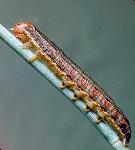COLUMBIA, Mo. – True armyworms are on the march this spring, and farmers need to be checking fields to make sure their crops aren’t among the casualties.
Related radio news story by Debbie Johnson. For downloadable broadcast-quality audio, contact Johnson at 573-882-9183.
“They often can take out an entire pasture of fescue or other grasses because numbers get so high, and also cut the heads off of wheat and feed on corn,” said Wayne Bailey, University of Missouri Extension state entomologist. “We know Arkansas is having a big problem with this insect in their grass pastures, and we think that problem is now spilling over into the lower three or four tiers of Missouri counties.”
Armyworm moths typically fly into Missouri from Mexico and southern states in spring. Each moth lays up to 1,300 eggs, and when the worms hatch they start feeding on crops.
This year, insects emerged early in southern climates and then migrated north ahead of schedule, thanks to unusually warm weather.
“Typically we see this problem about June 1, but reports have already started coming in from regional specialists and farmers about worms on numerous grass pastures and a few wheat fields,” Bailey said.
Fields might look fine, but armyworms work on plants from the bottom up. Once they chew through lower leaves they move up the grass stems. By the time damage is visible from a distance, it’s often too late.
If left unchecked, armyworms can decimate crops in just a few days.
“For example, if armyworms start cutting heads in wheat, they can take off 2-3 percent of heads the first day, 50 percent the second day and finish a crop off the third day if populations are elevated,” Bailey said. “Unlike a grasshopper that chops up the leaves as it goes, the true armyworm will chew off a layer of cells, come back and take another small portion, working all the way around the wound. It’s a very smooth type of hole you might see in the plant, usually coming in from the outer edge of a plant.”
True armyworms got their name because they can move in a mass, marching in lines from one destroyed field to their next feeding ground. While there are two or three generations of the insect each year, the first one causes most damage to field and forage crops. They are called true armyworms to differentiate them from fall armyworms, which show up toward the middle of the growing season.
When small, the worms tend to be green, but as they grow they typically turn a tan color, with tan stripes and one orange stripe down their sides. These worms have four sets of prolegs in the midsection and one set on the back end characterized by a black triangle at the feet.
To scout, farmers need to look near the ground in pastures and fields.
“You really have to scout in late afternoon or early morning or on cloudy days. You have to get down and look through the leaf litter on the ground and at the lower leaves of the plant,” Bailey said. “You are looking for areas that have been eaten with very smooth edges, and for larvae.”
The economic threshold at which it becomes profitable to spray insecticides depends on the number of worms. If there are more than four half-grown worms per square foot in grass pastures or wheat fields, farmers should consider spraying.
“There’s no substitute for good scouting in field and forage crops,” Bailey said. “Corn and wheat can be treated with several classes of insecticides, but on fescue and other grasses the options are limited to Sevin, Malathion, Mustang Max, Warrior II, plus two biological insecticides.”
Pre-harvest intervals—the time between spraying and grazing or haying—range from zero to 14 days, depending on the insecticide.
Read more about true armyworm and treatment in the MU Integrated Pest and Crop Management newsletter at ipm.missouri.edu/IPCM/index.cfm?ID=293 or in the MU Extension guide at www.extension.missouri.edu/G7115.
Read more http://extension.missouri.edu/news/DisplayStory.aspx?N=1400





